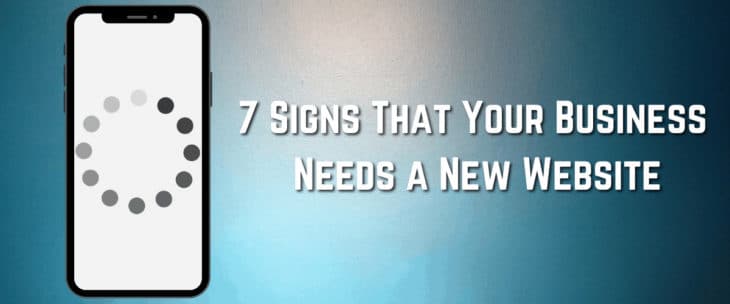1. Your Website Takes Forever to Load
This is generation now, and folks don’t want to wait for a website to load. If your site is slower than molasses, that valuable web traffic will jump back into the search results and visit a competitor’s site instead. Even worse, slow websites will take a hit in Google search rankings.
And that’s nothing new. Google started using site speed as a ranking signal in 2010, and doubled down in 2018 by applying page speed as a ranking factor in mobile search results. And as of May 2021, Google has incorporated a major ranking factor called “Page Experience,” of which the number-one component is loading speed.
Just how slow is your site? Don’t rely on your personal experience, as your browser will have cached those pages. Check your speed with Google PageSpeed Insights.
2. Your Website Is Not Mobile-Optimized (Responsive)
More than half of all internet searches now take place using mobile devices like smartphones and tablets. If your site isn’t optimized for these devices, you’re turning off a lot of prospective customers, and arguably losing a lot of business. This one is basically a no-brainer: if your site isn’t mobile-friendly, it’s time for a new site.
Being responsive — meaning the site adjusts to multiple display settings and devices — isn’t enough nowadays. You need to make your site mobile-first, as it will load faster. Furthermore, Google and other search engines now gauge their search results from the perspective of mobile devices and not desktop computers. There is no indication that user engagement will do anything but increase on mobile devices, so your new website should utilize a mobile-first design.
3. The Bounce Rate Is Sky-High
Your website’s bounce rate (which you can find in your Google Analytics reports) is the percentage of visitors who land on your website and then leave without looking at any other pages on the site.
A bounce rate around 50 percent or less is generally considered good. The criteria for determining what is a “good” bounce rate include a number of factors (i.e., your home page versus a blog post). Users landed on your site because they thought they’d find something they wanted there, but if most are quickly leaving without taking any action, then they aren’t finding it. Great web design will help visitors find what they need and encourage them to take action.
4. You’re Not Ranking in Google Search Results
There’s a lot involved in SEO (search engine optimization), so start simple with organic and branded searches. As search engines usually know precisely where users are located, you should be ranking highly for important keywords relative to your business.
When your website isn’t ranking near the top of organic search results for important keywords, then you are missing out on traffic, leads, and sales. If you’re hard to find, then your site likely needs some work under the hood and possibly even ads to successfully compete.
And if you’re not in the top three results when your own brand name is used in the search, then you’re in big trouble! Search engines are so good that most people don’t bother to remember domains that they don’t use constantly, opting to just search for their target in Google instead.
Creating a new site that is optimized for SEO (shall we mention how often Google updates their algorithms?) can cause a dramatic shift in your search engine rankings.
5. It’s Been 5+ Years Since Your Last Website Redesign
How does your website look compared to your competitors? Consider how quickly electronics and technology are updated or improved. With near-constant changes in search algorithms, an ever-growing supply of new applications, and varying trends in design, a website more than five years old is very likely hurting your business.
It’s not just cosmetics, either. Big slider images were very popular a few years ago, but then we all realized that a series of huge images on websites can lead to slow loading speeds, negatively impacting user experience.
There are also an enormous number of useful new tools, widgets, and applications that can be worked into your new site. Take the opportunity to incorporate things like responsive home pages (that change the content on the page according to what brought the user there), maps, automation, online scheduling, or a hundred other things that will improve conversion and save you time.
6. Your Website Isn’t HTTPS
HTTPS is a way to encrypt information that you send between a browser and a web server. The way that happens is with an SSL certificate. This protects your website’s users from “man-in-the-middle” attacks, where someone steals the information being sent to a website, like credit card information or logins.
In the past, only sites with sensitive information have been HTTPS, but as it has become easier to implement, it is becoming the standard. Nowadays, users expect secure sites and are wary of trusting sites that aren’t labeled as secure. The last thing you want is for Google to warn users about your site, so update your site now if you aren’t using an HTTPS protocol.
7. You Have Poor Conversion Rates
Leads are great; conversions are better. Whether you’re bringing in lots of traffic organically or with paid ads, it’s a shame if those leads don’t convert. It could be slow loading times, confusing navigation, broken links — or they just don’t find your site useful.
All the reasons we’ve outlined on this list can contribute to poor conversion rates. Your website is a tool to help you achieve your key marketing goals. Plain and simple, if you aren’t getting enough leads or conversions from your site, it’s likely time for an upgrade.
Book Your FREE 15-Minute Website Planning Session
Did your website fall under one of the categories above? If that’s the case, then it’s time you schedule a website redesign consult with Mvestor Media.
Ian Rogers

